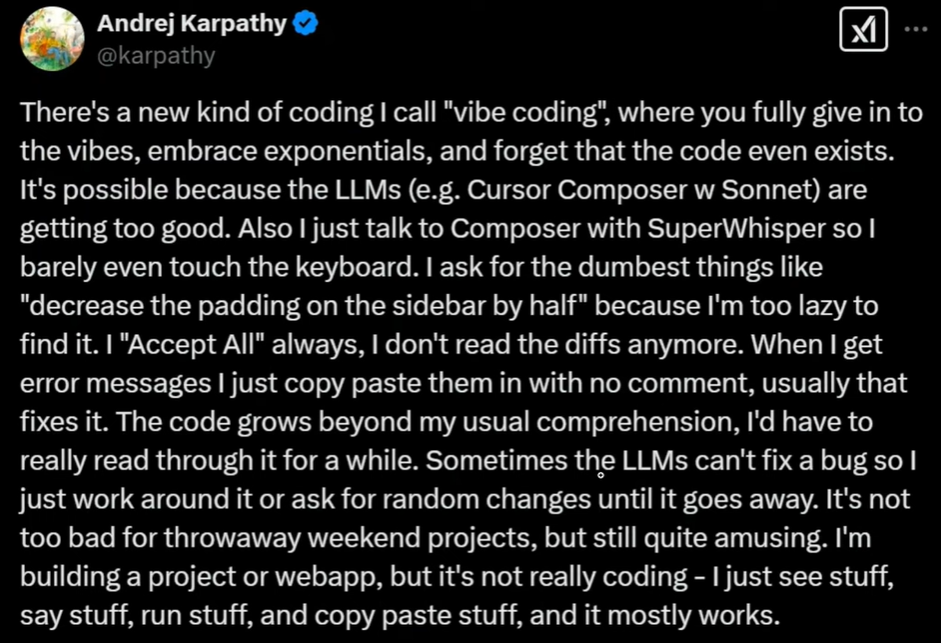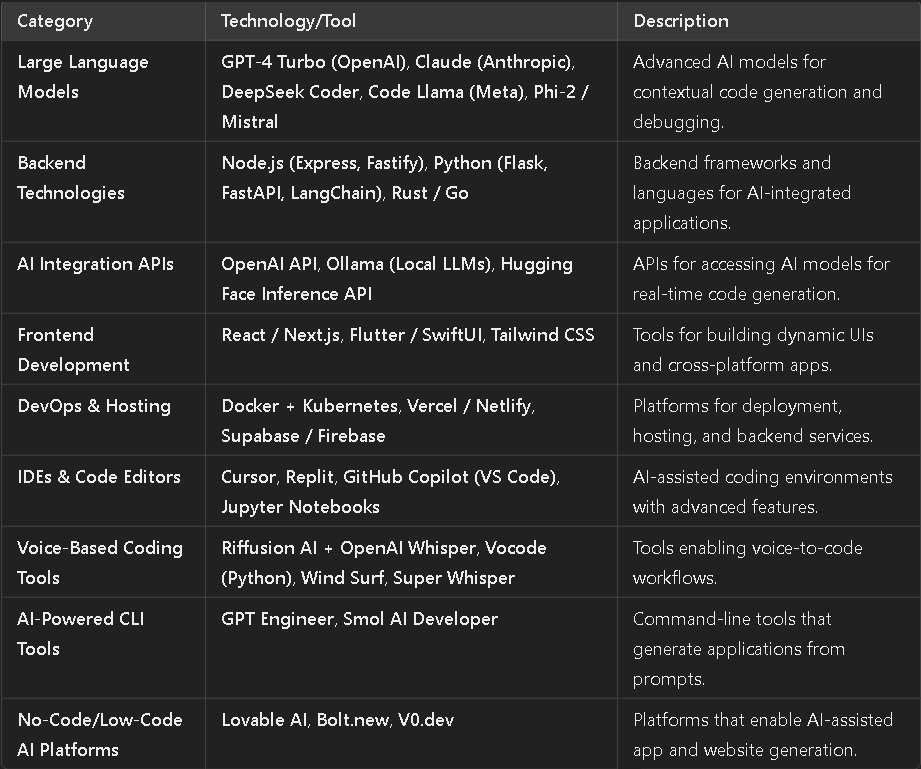Vibe Coding
 Aishwary Gupta
Aishwary Gupta
The rise of the buzzword vibe coding is a revolutionary approach to web development that utilizes AI to translate natural language prompts into functional websites and applications.

We'll delve into the technology behind this trend, examine leading platforms, and consider its impact on traditional web development. We'll also discuss the emerging role of prompt engineers and address ethical considerations before concluding with predictions for the future of AI-powered web development.

You’re not coding—you’re just vibing.
How LLM Power Vibe Coding
Large Language Models (LLMs) are at the heart of vibe coding. GPT variants, known for their advanced natural language processing capabilities, play a pivotal role in code generation. These models are trained on vast datasets of code and text, allowing them to understand human language and translate it into accurate code. The process involves analyzing the prompt, identifying the desired functionality, and generating code in languages like HTML, CSS, and JavaScript. For example, GPT-4 has demonstrated an impressive ability to generate 78% accurate code from text prompts, showcasing the potential of these models.
Leading Vibe Coding Platforms
Several platforms have emerged as leaders in the vibe coding space, each offering unique features and capabilities. Cursor, with its AI-powered IDE, boasts over 2.5 million active users. Replit, a collaborative coding platform, also incorporates AI integration. When comparing these platforms, factors like features, pricing, and user experience are critical considerations. Choosing the right platform depends on individual needs and preferences.
Cursor: | Offers AI-powered code completion, real-time suggestions, and automated testing features. It's ideal for developers seeking advanced assistance in various programming languages. |
|---|---|
Replit: | Provides a collaborative environment for code development, including AI-powered code generation, deployment, and team management tools. It's a great option for individuals and teams working on projects together. |
GitHub Copilot: | An AI pair programmer that offers code suggestions and autocompletion within the GitHub environment. It's designed to help developers write code faster and with less effort. |
SuperWhisper: | An advanced AI-powered speech-to-text tool designed for real-time, high-accuracy transcription and coding assistance. It enhances vibe coding workflows by allowing developers to dictate their code, describe logic, or even debug using voice commands. |
Amazon CodeWhisperer: | Provides real-time code suggestions based on existing code and comments. It supports multiple programming languages and integrates seamlessly with AWS services, making it suitable for cloud-based development. |
Developers as Prompt Engineers
The rise of vibe coding has led to the emergence of a new role: the AI Prompt Engineer. This role is rapidly gaining traction, with a 30% increase in job listings since last year. Prompt engineers possess a unique blend of skills, including natural language processing, context framing, and AI model understanding. They are responsible for crafting effective prompts that elicit desired outcomes from AI models. Top companies are integrating prompt engineering into their workflows, recognizing its potential to optimize AI-powered development.
A vibe coder with the right specialization outside of making software can be pretty powerful. The domain knowledge plus the ability to build can unlock a lot. With actual data, vibe coding is 4x more productive in terms of output, and 90% faster.
Key technologies and tools

Ethical Consideration and Limitations
Copyright concerns arise, with 22% of AI-generated code potentially violating existing licenses. You being a developer must be mindful of licensing agreements and ensure proper attribution for code generated using AI. Another ethical challenge stems from potential bias in AI models. These models are trained on large datasets, which may contain biases that could lead to unfair or discriminatory outcomes in generated code. Addressing these representation issues is critical for ensuring ethical and inclusive development practices.
Furthermore, over-reliance on AI can pose risks. While AI tools are powerful, it's crucial to maintain a balanced approach, using AI as an aid rather than a replacement for human expertise. Developers should retain their critical thinking and problem-solving skills, ensuring they can effectively evaluate and refine AI-generated code.
Made just by vibe coding
I may not have all the answers—sometimes, I don’t even have the right questions. But that’s okay. I just start, experiment, and keep going. The gaps fill themselves along the way. Vibe coding isn’t about knowing everything—it’s about building something beautiful and figuring it out as you go.
Even I have made some things using v0 and DeepSeek:
checkout my GitHub repo for more such animations and effects [Repo]
the list goes on…
Future Trends in AI-Powered Web Development
The future points towards significant advancements in the coming years. It is estimated that 80% of basic web development tasks will be automated by AI, freeing developers to focus on more complex and creative aspects of their work 😎. Emerging technologies like multi-modal AI will enable full-stack development, allowing developers to generate entire applications from a single prompt.
AI-powered web development will also integrate with other cutting-edge technologies, such as augmented reality (AR), virtual reality (VR), and the Internet of Things (IoT), creating immersive and interconnected experiences.
The future holds exciting possibilities for developers who embrace the power of AI and adapt their skills to this evolving landscape.
Conclusion
To thrive in this evolving landscape, developers must embrace continuous learning. Upskilling in areas like natural language processing, prompt engineering, and AI model understanding will be crucial. The future of web development is a collaborative one, where human creativity and AI ingenuity work hand-in-hand. As developers, we must embrace this revolution and use AI as a powerful tool to create innovative and engaging web experiences for users worldwide.
If you found this blog post helpful, please consider sharing it with others who might benefit. You can also follow me for more content on tech-reacted topics.
Connect with me on Twitter, LinkedIn, and GitHub.
🎊 Read More Here👈🏻

Subscribe to my newsletter
Read articles from Aishwary Gupta directly inside your inbox. Subscribe to the newsletter, and don't miss out.
Written by


